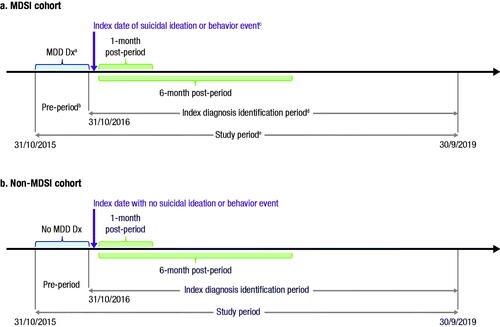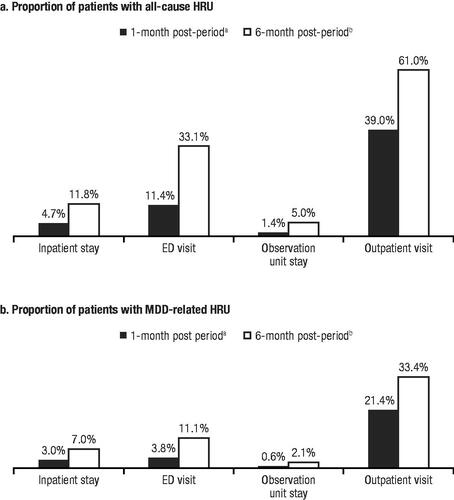Figures & data
Figure 1. Study design. (a) MDSI cohort. (b) Non-MDSI cohort. Abbreviations: MDSI, major depressive disorder and acute suicidal ideation or behavior; MDD, major depressive disorder; Dx, diagnosis. a≥1 diagnosis for MDD or other depressive disorder within the 12 months prior to or on the index date. b≥12 months of health care activity prior to the index period. cThe date of the first occurrence of suicidal ideation is defined as the index date and could occur any time within the index period. d≥1 diagnosis code for acute suicidal ideation or behavior during 31 October 2016 to 30 September 2019. e≥1 diagnosis for a depressive disorder during the study period.

Table 1. Baseline characteristics in the MDSI cohort, matched non-MDSI cohort, and standard differences in propensity score–matched cohorts.
Table 2. Depression and other mental health–related treatments recorded for patients with MDSI.
Table 3. PHQ-9 scores for the MDSI cohorta.
Table 4. Shifts in PHQ-9 score categories for patients with MDSI with scores during pre- and 6-month post-periods (n = 1,139)a.
Figure 2. Post-period HRU in the MDSI cohort. (a) Proportion of patients with all-cause HRU. (b) Proportion of patients with MDD-related HRU. Abbreviations: HRU, health care resource utilization; MDSI, major depressive disorder and acute suicidal ideation or behavior; ED, emergency department; MDD, major depressive disorder. aHRU reported for the 57,058 patients in the MDSI cohort with ≥1 month of data in the post-period. bHRU reported for the 40,261 patients in the MDSI cohort with ≥6 months of data in the post-period.

Figure 3. All-cause HRU: MDSI versus non-MDSI cohorts. (a) During the 1-month post-period. (b) During the 6-month post-period. Abbreviations: HRU, health care resource utilization; MDSI, major depressive disorder and acute suicidal ideation or behavior; OR, odds ratio; CI, confidence interval; ED, emergency department.

Supplemental Material
Download MS Word (21.2 KB)Data sharing statement
The data that support the findings of this study are not publicly available due to privacy or ethical restrictions.
